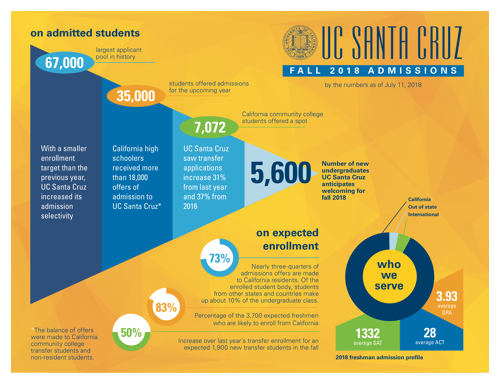UC Santa Cruz offered admission to 35,000 students for the upcoming academic year, marking more than a 30 percent increase in the number of offers extended to students from California’s community colleges.
Faced with the largest applicant pool in campus history—67,000 applications—and a smaller enrollment target than the previous year, UC Santa Cruz increased its admission selectivity, based on numbers released today (July 11) by the UC Office of the President. This year’s admitted freshmen had an average GPA of 3.93, average (new) SAT scores of 1322, and an average ACT of 28.
“Santa Cruz offers a distinctive UC education within its 10 residential colleges, where students prepare for the future with foci on critical thinking, social justice, technology, the arts, sciences, and most importantly, learning how to make a difference through study, innovation, and teamwork across differences,” said Vice Provost and Dean of Undergraduate Education Richard Hughey. “It is always exciting to see the expanding interest in our campus, though unfortunate that we are not able to accommodate all students wishing to join our community.”
Still, California’s high schoolers received the majority of offers with more than 18,000 gaining acceptance to UC Santa Cruz.
Total freshmen admission offers declined slightly (by 0.8 percent), reflecting both an exceptionally large entering class back in fall 2016 and smaller enrollment targets for fall 2018.
With a steep rise in the number of transfer applications, UC Santa Cruz increased admissions offers to California community college students, offering a spot to 7,072 students, a 31 percent increase from last year and a 37 percent increase from 2016.
UC Santa Cruz anticipates welcoming about 5,600 new undergraduates who have selected the campus for its exceptional commitment to social justice, track record for high-impact research, supportive student resource centers, and opportunities to work with faculty members on research projects and performances.
The campus expects to enroll approximately 3,700 new freshmen, about 5 out of 6 students from California, and the remainder coming from other states or countries.
Faculty and staff are preparing to welcome the new class into UC Santa Cruz’s distinctive residential colleges, Summer Academies, Scholars Program, and new federally funded programs related to the campus’s Hispanic Serving Institution (HSI) status, and ever-expanding opportunities for undergraduate research, internships, and creative projects with world-class faculty.
“A focus of the entire campus this year was to grow the portion of entering California transfer students in response to a state legislative mandate to shift the portion of students entering UC and each campus from the transfer pathway rather than directly from high school ,” said Hughey. “The work, in partnership with the California Community Colleges and the UC Office of the President has been exceptionally successful.”
UC Santa Cruz expects to enroll 1,900 new transfer students in fall, 50 percent more than last year. Overall, the campus expects to enroll about 200 more California students than last year, with a reduction in California freshman and an increase in California transfer students.
Campus diversity remains strong with the percentage of admitted African American, American Indian, Asian American, and Chicano/Latino students remaining steady.
The campus admitted 774 African American students from California high schools, accounting for 4.1 percent of all California frosh admits, about the same as last year. The campus remains committed to reaching a critical mass of African American undergraduates in order to create a more inclusive environment. The near-term goal is to increase from the current 4.2 percent of overall undergraduate enrollments to 5 percent. Students, staff, faculty, and alumni continue to collaborate on ways to enhance the campus climate.
Recruiting students from other countries and states remains a campus goal, both to maintain an inclusive campus and to bring more perspectives that can contribute to a dynamic social and cultural atmosphere. The campus offered admission to 2,957 out-of-state students and 5,288 international freshmen. The campus anticipates having about 700 new freshman and transfer students from other states or countries enroll this fall. Students from other states and countries comprise about 10 percent of the undergraduate class.




